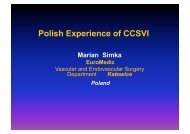ISNVD Abstract Book
ISNVD Abstract Book
ISNVD Abstract Book
Create successful ePaper yourself
Turn your PDF publications into a flip-book with our unique Google optimized e-Paper software.
Magnetic Resonance Imaging (MRI) Traumatic Brain Injury Protocol<br />
The MRI TBI Protocol uses a conventional neuroimaging protocol for MS with additional specialized<br />
sequences to study the vasculature in the brain, neck and spine as well as the iron content in the brain.<br />
On the vascular side, both anatomic and flow information is collected. A major benefit of using MRI is<br />
that it provides the neurologist with what he needs for assessing MS, it provides the interventionalist 3D<br />
planning and it provides all parties with critical flow information which may well become a key marker<br />
for deciding when or when not to treat a patient. MRI is also operator independent for the most part<br />
and the same protocols can be run on most manufacturers’ systems. The data are also easily reproduced<br />
when run on the same equipment from site to site. Potential biomarkers for CCSVI and MS can be<br />
identified from the data. MRI can also longitudinally track the progress of the disease over time via<br />
lesion counts and type, physiologic changes like blood flow and cerebrospinal fluid (CSF) dynamics, and<br />
provide a baseline for future scans.<br />
The following imaging protocol is presented for a 3-Tesla Siemens Scanner but can be extended to other<br />
field strengths and manufacturers. The scans proposed are: 2D time of flight MR venography (TOF<br />
MRV), time-resolved contrast enhanced 3D MR angiography and venography (MRAV), 3D volumetric<br />
interpolated breath-hold examination (VIBE), phase-contrast flow data at different levels in the neck and<br />
thoracic cavity, as well as the conventional T2 weighted imaging (T2WI), T2 fluid attenuated inversion<br />
recovery (FLAIR), susceptibility weighted imaging (SWI), and pre and post contrast T1 weighted imaging<br />
(T1WI) or magnetization prepared rapid gradient echo (MPRAGE) imaging. Perfusion scanning can also<br />
be added into this protocol for a small increment in time (roughly 3 minutes extra). Finally, we add<br />
diffusion tensor imaging (DTI) as a measure of microscopic changes in water diffusion. Both fractional<br />
anisotropy (FA) and apparent diffusion coefficient (ADC) measures are used from this data.<br />
2D TOF MRV scans are used to detect blood flow in arteries and veins. Using a saturation band, any flow<br />
toward the head (arterial flow) will be saturated, and the flow towards the heart (venous flow) will be<br />
highlighted in a velocity-dependent manner. From this sequence, veins are well visualized and it can be<br />
determined if they are patent, occluded, or stenosed. Since the data are collected with high resolution,<br />
vessel cross-section can also be calculated to evaluate the degree of stenosis.<br />
3D CE MRAV can also be used to evaluate vascular abnormalities. The scan uses a T1 reducing contrast<br />
agent which passes through all vessels and leads to increased signal for vessels in T1 weighted scans.<br />
From the data, 3D anatomical assessments can be done to evaluate vessel patency. Atresias, aplasias,<br />
truncular malformations, valve issues, and stenoses can be detected.<br />
3D VIBE pre- and post-contrast can be used to evaluate structural patency of vessels as well as<br />
inhomogeneous enhancement of the tissue. It is an alternate approach to the 3D dynamic CE approach<br />
just discussed and takes much longer (although still relatively fast).<br />
2D PC-MRI images are used to assess flow dynamics in the head and neck veins and arteries, the azygous<br />
vein, and CSF at the C2 cervical level. This information is valuable because it can both corroborate and<br />
compliment the information seen in the 2D TOF MRV and 3D CE MRAV. It is not uncommon to visualize<br />
the major veins only later to find that many of the veins have compromised blood flow.<br />
Susceptibility Weighted Imaging (SWI) is useful because the image contrast is based on the intrinsic<br />
susceptibilities of tissues. For example, veins are rich in deoxyhemoglobin which is paramagnetic and<br />
provides clear visibility of venous structures. Quantification of iron in the gray matter as well as lesions




